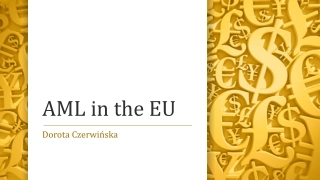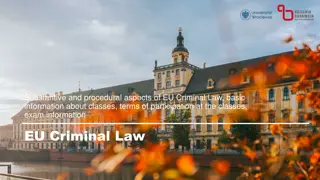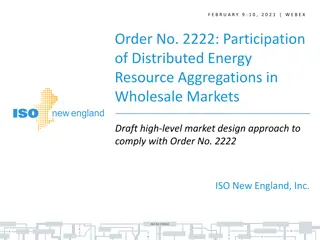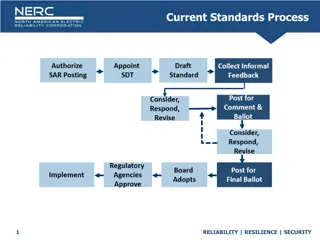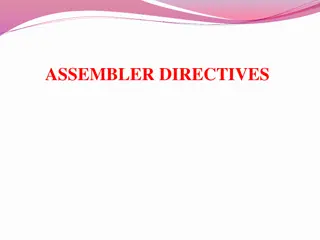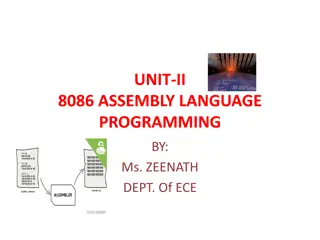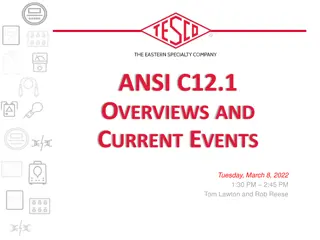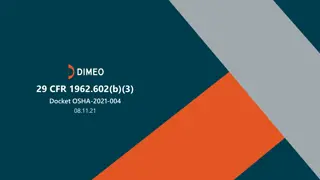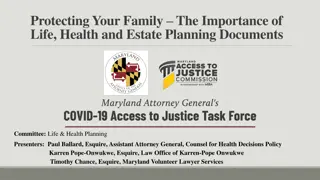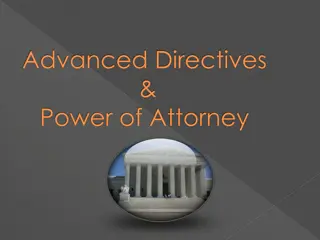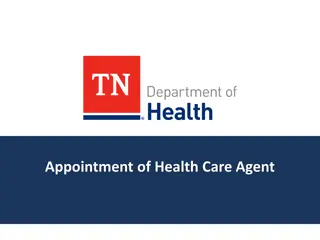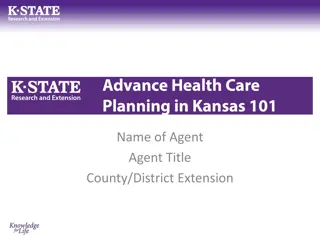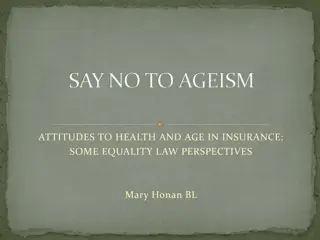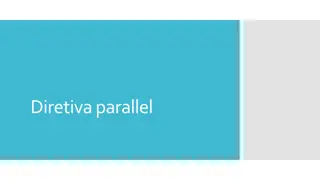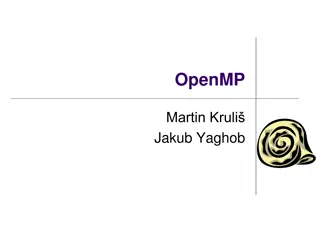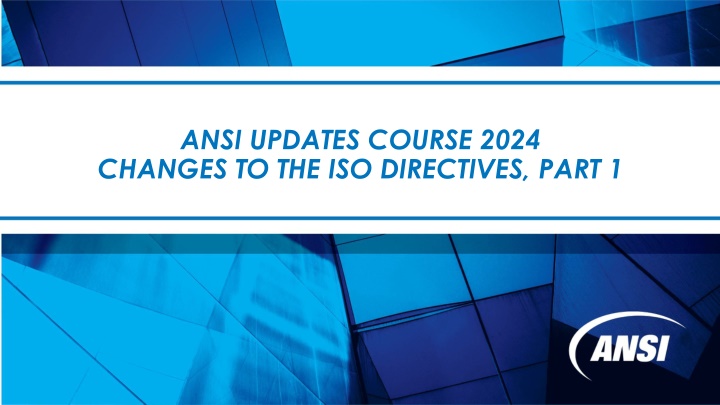
Changes to ISO Directives: 2024 Updates & Compliance Instructions
Stay informed about the latest changes to the ISO Directives in 2024 through a comprehensive course. After completion, ensure compliance by sending a confirmation email to ANSI's ISO Team. Learn about important updates regarding committee procedures, voting principles, and committee status changes. Committee leaders and US/TAGs must adhere to the new provisions outlined in the ISO/IEC Directives. For detailed compliance instructions and course completion, refer to the provided information.
Download Presentation

Please find below an Image/Link to download the presentation.
The content on the website is provided AS IS for your information and personal use only. It may not be sold, licensed, or shared on other websites without obtaining consent from the author. If you encounter any issues during the download, it is possible that the publisher has removed the file from their server.
You are allowed to download the files provided on this website for personal or commercial use, subject to the condition that they are used lawfully. All files are the property of their respective owners.
The content on the website is provided AS IS for your information and personal use only. It may not be sold, licensed, or shared on other websites without obtaining consent from the author.
E N D
Presentation Transcript
ANSI UPDATES COURSE 2024 CHANGES TO THE ISO DIRECTIVES, PART 1
Course Completion Compliance Instructions After completing this course, you must send an email confirming its completion to comply with the ANSI Executive Standards Council requirement for training on new changes to the ISO Directives, processes, and procedures that are introduced each year. Please send an email to ANSI's ISO Team via this link confirming you've completed the course and including the following information: Name Email address ISO Committee or U.S. TAG Role (ISO Committee Manager or Chair, U.S. TAG Administrator or Chair) If you have questions or need any assistance, please email isot@ansi.org.
ISO/IEC DIRECTIVES PART 1 FOREWORD & CLAUSE 1.7.5 GENERAL PRINCIPLES FOR VOTING AND DECISIONS WHAT S NEW? Text has been moved into the main body of the Directives as new clause 1.7.5 as these are requirements on committees and should be in the main body of the Directives rather than the Foreword. WHAT DOES THIS MEAN FOR COMMITTEE CHAIRS, MANAGERS AND CONVENORS? Committee leaders shall conduct themselves consistent with these provisions, which are unchanged from the previous edition of the Directives, Part 1; they have only been moved. WHAT DOES THIS MEAN FOR US/TAGs? US/TAGs should also conduct themselves consistent with these provisions.
ISO/IEC DIRECTIVES PART 1 FOREWORD COMMITTEE SPECIFIC PROCEDURES WHAT S NEW? Text has been removed regarding requests for committee specific procedures. Instead, committees are encouraged to develop and submit change requests for the Directives in a generic sense for application in all committees rather than pursue development and ISO/TMB approval of committee specific procedures (please see the Foreword, clause 0.6). Any existing committee specific procedures previously approved remain in effect. WHAT DOES THIS MEAN FOR COMMITTEE CHAIRS, MANAGERS AND CONVENORS? If a committee identifies a need for new procedures or improvements to existing procedures in the Directives, the committee leadership should obtain committee consensus on this need and develop/submit a proposal using the regular change request form for the Directives. WHAT DOES THIS MEAN FOR US/TAGs? US/TAGs should contribute to committee discussions and decisions on any proposed changes to procedures.
ISO/IEC DIRECTIVES PART 1 CLAUSE 1.5.12 COMMITTEES IN STAND-BY STATUS WHAT S NEW? The removal of this clause eliminates the concept of committees in stand-by or dormant status. Committees currently on stand-by will not be automatically disbanded, and an assessment will be made by the ISO/TMB before disbanding them. The reactivation of ISO standards development in an area covered by a disbanded committee that was previously in stand-by will require the development, submittal and approval of a new ISO Form 1 for formation of a new technical area. WHAT DOES THIS MEAN FOR COMMITTEE CHAIRS, MANAGERS AND CONVENORS? Committee leaders of committees currently in stand-by may lose these leadership roles if the ISO/TMB disbands the committee. WHAT DOES THIS MEAN FOR US/TAGs? None, as ANSI would no longer have US/TAGs for disbanded committees. However, if US stakeholders wish to reintroduce a subject area to ISO previous addressed in a disbanded committee, they should work with ANSI staff to prepare a formal proposal for submittal and consideration by ISO.
ISO/IEC DIRECTIVES PART 1 CLAUSE 1.9.1 ROTATION OF SECRETARIATS WHAT S NEW? Two NSBs may no longer adopt an agreement to rotate the secretariat of a committee between the two NSBs on a regular basis as there was little interest or take up of this possibility. In the case of the one committee that uses this practice, it was agreed to allow this one exception to continue. WHAT DOES THIS MEAN FOR COMMITTEE CHAIRS, MANAGERS AND CONVENORS? Committee leaders can no longer consider this practice. WHAT DOES THIS MEAN FOR US/TAGs? There is no impact on US/TAGs.
ISO/IEC DIRECTIVES PART 1 CLAUSE 1.12.2 GUESTS IN WORKING GROUP MEETINGS WHAT S NEW? Text was revised to clarify that if the ongoing participation of a guest is necessary in a WG beyond two meetings to contribute to the work, that guest should pursue becoming an official WG expert via his or her NSB or a liaison organization. WHAT DOES THIS MEAN FOR COMMITTEE CHAIRS, MANAGERS AND CONVENORS? WG convenors shall ensure compliance with this provision in cases where the ongoing engagement of the guest individual is necessary. WHAT DOES THIS MEAN FOR US/TAGs? US/TAGs may be asked to consider making a guest from the USA an official WG expert in some cases.
ISO/IEC DIRECTIVES PART 1 CLAUSES 1.17.7 & 1.17.8 PERIODIC REVIEW AND TERMINATION OF LIAISONS WHAT S NEW? External liaisons shall be reviewed at each plenary or at minimum one per year to determine if they are still viable and the liaison role is being fulfilled. In the event that the committee or its subgroup or the liaison organization feels that the liaison should be terminated, the parties are encouraged to discuss the matter to seek resolution. If such resolution cannot be achieved, the liaison may be terminated by unilateral decision of any of the parties to the liaison. WHAT DOES THIS MEAN FOR COMMITTEE CHAIRS, MANAGERS AND CONVENORS? Committee leaders shall conduct periodic reviews and terminations of liaisons in compliance with these provisions. WHAT DOES THIS MEAN FOR US/TAGs? There is no direct impact on US/TAGs.
ISO/IEC DIRECTIVES PART 1 CLAUSE 2.1.6 INTERLABORATORY TESTING WHAT S NEW? Time spent on interlaboratory testing will not be counted in the overall standards development time for the project. The project will be considered on hold during such testing, and the committee shall review the status of such testing at each plenary meeting. WHAT DOES THIS MEAN FOR COMMITTEE CHAIRS, MANAGERS AND CONVENORS? Committee leaders shall inform their TPMS of periods of interlaboratory testing so that the projects shall be registered as on-hold . Committee leaders will also ensure that the status of such testing on any projects is considered at each plenary meeting. WHAT DOES THIS MEAN FOR US/TAGs? There is no direct impact on US/TAGs.
ISO/IEC DIRECTIVES PART 1 CLAUSE 2.2 PRELIMINARY STAGE WHAT S NEW? A number of revisions/additions were made to this clause to add and align ISO, IEC and JTC1 procedures and guidance related to handling preliminary work items. WHAT DOES THIS MEAN FOR COMMITTEE CHAIRS, MANAGERS AND CONVENORS? Committee leaders shall review this clause and conduct the work of the committee accordingly. WHAT DOES THIS MEAN FOR US/TAGs? US/TAGs may decide to name experts to be engaged in the development and discussions at the preliminary stage.
ISO/IEC DIRECTIVES PART 1 CLAUSE 2.3 HANDLING OF NWIP BALLOT RESULTS WHAT S NEW? A number of additions/revisions have been made to this clause to align IEC and ISO procedures plus modifications to enhance clarity regarding the handling of ballot results. The key modification to the existing practice is the addition of the explicit step where the Committee Manager issues a 4- week ballot to add experts should criteria 2.3.5 a) passes but criteria 2.3.5 b) fails. WHAT DOES THIS MEAN FOR COMMITTEE CHAIRS, MANAGERS AND CONVENORS? Committee leaders shall conduct the work consistent with the provisions in this clause. WHAT DOES THIS MEAN FOR US/TAGs? US/TAGs shall determine their NWIP voting positions and name experts with their ballots if voting approval as required in this clause.
ISO/IEC DIRECTIVES PART 1 CLAUSE 2.5.2 CD STAGE COMMENTING PERIOD WHAT S NEW? Text has been clarified that 8 weeks is the default time period for CD commenting, which the committee may increase up to a maximum of 16 weeks by committee consensus decision. WHAT DOES THIS MEAN FOR COMMITTEE CHAIRS, MANAGERS AND CONVENORS? Committee leaders shall work with their P members to reach consensus on the length of a CD commenting period. WHAT DOES THIS MEAN FOR US/TAGs? US/TAGs should consider and advocate for the time period they feel they need for effective consideration and development of consensus comments on a CD.
ISO/IEC DIRECTIVES PART 1 CLAUSE 2.6.2 & 2.7.2 HANDLING VOTING ON DIS & FDIS WHAT S NEW? A number of revisions have been made to align ISO and IEC procedures related to handling voting following DIS and FDIS votes. WHAT DOES THIS MEAN FOR COMMITTEE CHAIRS, MANAGERS AND CONVENORS? Committee leaders shall handle the results of DIS and FDIS voting consistent with this clause. WHAT DOES THIS MEAN FOR US/TAGs? US/TAGs shall develop and submit positions on DIS and FDIS consistent with this clause.
ISO/IEC DIRECTIVES PART 1 CLAUSE 2.10 TECHNICAL CORRIGENDA WHAT S NEW? ISO committees may again develop and issue technical corrigenda to their standards. WHAT DOES THIS MEAN FOR COMMITTEE CHAIRS, MANAGERS AND CONVENORS? Committee leaders shall develop, seek committee consensus and submit technical corrigenda for publication consistent with this clause. WHAT DOES THIS MEAN FOR US/TAGs? US/TAGs shall take positions on any proposals for technical corrigenda.
ISO/IEC DIRECTIVES PART 1 CLAUSES 3.1.2 & 3.3.1 TECHNICAL SPECIFICATIONS AND TECHNICAL REPORTS WHAT S NEW? If a P member votes negatively on a TS or TR ballot without providing technical comments/justification, the vote will not be counted. WHAT DOES THIS MEAN FOR COMMITTEE CHAIRS, MANAGERS AND CONVENORS? Committee leaders shall handle the voting on TSs and TRs consistent with these clauses. WHAT DOES THIS MEAN FOR US/TAGs? US/TAGs shall provide technical comments/justifications with any negative votes on TSs or TRs.
ISO/IEC DIRECTIVES PART 1 CLAUSE 3.3.2 BALLOT TIME FOR TECHNICAL REPORTS WHAT S NEW? The text has been revised to require that if changes other than editorial are made to a draft TR after balloting, an additional 4 week ballot shall be issued to confirm final consensus on the document. WHAT DOES THIS MEAN FOR COMMITTEE CHAIRS, MANAGERS AND CONVENORS? Committee managers shall ensure the issuance of an additional 4 week ballot in such cases. WHAT DOES THIS MEAN FOR US/TAGs? US/TAGs shall decide on and submit votes on all TR ballots.
ISO/IEC DIRECTIVES PART 1 CLAUSE 4.1 SCHEDULING OF MEETINGS WHAT S NEW? Text has been added that committee meetings shall be convened by the committee secretariat at intervals deemed necessary by the committee to manage and advance the work, and such meeting shall be of sufficient duration to complete all agenda items. Text has also been added to encourage the possible grouping of related meetings, not just at the committees level but also at the working groups level. WHAT DOES THIS MEAN FOR COMMITTEE CHAIRS, MANAGERS AND CONVENORS? Committee leaders shall manage committee decisions on the scheduling of meetings consistent with these provisions. WHAT DOES THIS MEAN FOR US/TAGs? US/TAGS shall take decisions on the scheduling of committee and working group meetings and ensure that the USA is represented when such meetings take place.
ISO/IEC DIRECTIVES PART 1 CLAUSE 4.2 ORGANIZATION OF MEETINGS WHAT S NEW? Text has been added such that: P and O members must register their representatives in the ISO Meetings application 1. It is the responsibility of the host country to issue any letters of invitation needed for any meetings 2. If a committee is over-running its time, the committee may decide to: 1) extend the duration of the meeting is unanimously agreed, or 2) continue the meeting but any decisions that arise after the posted end time for the meeting shall be take by correspondence after the meeting 3. WHAT DOES THIS MEAN FOR COMMITTEE CHAIRS, MANAGERS AND CONVENORS? In relation to item 3 above, the committee leaders will have the committee take a consensus decision regarding extending the meeting and follow-though on any necessary ballots deferred until after the meeting. WHAT DOES THIS MEAN FOR US/TAGs? US/TAGs shall ensure that their representatives are registered in the ISO Meetings application.
ISO/IEC DIRECTIVES PART 1 CLAUSE 4.5 PARTICIPATION BY CORRESPONDENCE WHAT S NEW? This is a new clause that provides detailed procedures for how committee leaders and P members should handle participation by correspondence in plenary meetings. This has been mentioned in the Directives Part 1 for many years, but there was little detail before on how this should be handled. Please note that participation by correspondence is only possible if virtual participation is not offered for the plenary meeting. WHAT DOES THIS MEAN FOR COMMITTEE CHAIRS, MANAGERS AND CONVENORS? Committee leaders should review and implement this clause for those P members that wish to participate by correspondence when virtual participation is not offered. WHAT DOES THIS MEAN FOR US/TAGs? US/TAGs should decide if they wish to participate by correspondence if representatives are not available to travel and virtual participation is not offered. If a US/TAG decides to participate by correspondence, it shall comply with the provisions of this clause.
ISO/IEC DIRECTIVES PART 1 CLAUSE 5.1.1 APPEALS WHAT S NEW? The Directives Part 1 have been aligned between ISO and IEC to require that an appeal must be filed within 8 weeks of the committee decision that is being appealed. WHAT DOES THIS MEAN FOR COMMITTEE CHAIRS, MANAGERS AND CONVENORS? Committee leaders shall only accept appeals submitted within 8 weeks of the committee decision being appealed. WHAT DOES THIS MEAN FOR US/TAGs? US/TAGs wishing to file an appeal shall ensure that they develop their appeal, have US/TAG consensus to submit the appeal, and formally submit the appeal within 8 weeks of the committee decision being appealed.
ISO/IEC DIRECTIVES PART 1 ANNEX M HORIZONTAL DCOUMENTS WHAT S NEW? This is a new annex that presents the common approach agreed in ISO and IEC on horizontal documents, which are defined in clause M.2. WHAT DOES THIS MEAN FOR COMMITTEE CHAIRS, MANAGERS AND CONVENORS? Committee leaders shall implement committee decisions and activities related to developing horizontal documents consistent with this clause. WHAT DOES THIS MEAN FOR US/TAGs? US/TAGs may decide by correspondence to submit proposals for horizontal documents and/or take consensus decisions on horizontal documents under development in their ISO committees.
ISO/IEC DIRECTIVES PART 1 ANNEX SG OTHER NON-OFFICIAL LANGUAGES WHAT S NEW? Languages other than the official languages of ISO may only be included in the body of vocabularies. This is contingent on the committee agreeing to a business case for including such a language submitted by a P member that is then responsible for text in that language. The business case accepted by the committee shall also be submitted to ISO/CS. WHAT DOES THIS MEAN FOR COMMITTEE CHAIRS, MANAGERS AND CONVENORS? Committee leaders shall manage requests from P members for including other non-official languages consistent with clause SG.3. WHAT DOES THIS MEAN FOR US/TAGs? No possible impacts foreseen for US/TAGs.
ISO/IEC DIRECTIVES PART 1 ANNEX SI INTERNATIONAL WORKSHOP AGREEMENTS WHAT S NEW? A sentence has been added to clause SI.8 that a listing of the listing of participants in the development of an IWA will only provide the names of the organizations participating and their counties, with no other information being provided, to be consistent with data privacy regulations. WHAT DOES THIS MEAN FOR COMMITTEE CHAIRS, MANAGERS AND CONVENORS? Chairs and Secretaries of IWA development efforts shall ensure that the listing of participants complies with this sentence in clause SI.8. WHAT DOES THIS MEAN FOR US/TAGs? No possible impacts foreseen for US/TAGs
ISO/IEC DIRECTIVES PART 1 ANNEX SM GLOBAL RELEVANCE WHAT S NEW? Text in clause SM.1 has been revised/updated to correct references to the relevant WTO TBT documents. WHAT DOES THIS MEAN FOR COMMITTEE CHAIRS, MANAGERS AND CONVENORS?\ No possible impacts foreseen for committee leaders WHAT DOES THIS MEAN FOR US/TAGs? No possible impacts foreseen for US/TAGs
ISO/IEC DIRECTIVES PART 1 ANNEXES SL & SP DEFINITION OF RISK WHAT S NEW? Text has been revised in both Annex SL and Annex SP to support an ISO/TMB decision that gives committees flexibility to choose to use the definition of risk decided by the committee consensus. WHAT DOES THIS MEAN FOR COMMITTEE CHAIRS, MANAGERS AND CONVENORS? Committee leaders shall ensure that their P members decide which definition of risk will be used in the committee s deliverables without external and artificial pressures for the committee to use a specific definition. WHAT DOES THIS MEAN FOR US/TAGs? US/TAGs shall be engaged in committee decisions on the definition of risk that the committee will use in its deliverables.
ISO/IEC DIRECTIVES PART 1 ANNEX SP OCCUPATIONAL HEALTH AND SAFETY WHAT S NEW? A new clause SP.5.7 has been added to address coherence between generic and sector specific deliverables for occupational health and safety. WHAT DOES THIS MEAN FOR COMMITTEE CHAIRS, MANAGERS AND CONVENORS? Committee leaders shall manage the work of their committees to develop sector specific occupational health and safety standards consistent with the provisions of clause SP.5.7 and respecting the generic standards. WHAT DOES THIS MEAN FOR US/TAGs? US/TAGs shall take positions on the develop of sector specific occupational health and safety standards respecting the provisions of this clause and the generic standards.
Course Completion Compliance Instructions After completing this course, you must send an email confirming its completion to comply with the ANSI Executive Standards Council requirement for training on new changes to the ISO Directives, processes, and procedures that are introduced each year. Please send an email to ANSI's ISO Team via this link confirming you've completed the course and including the following information: Name Email address ISO Committee or U.S. TAG Role (ISO Committee Manager or Chair, U.S. TAG Administrator or Chair) If you have questions or need any assistance, please email isot@ansi.org.
For Questions For questions on the content of this course, please contact Steve Cornish at scornish@ansi.org or 1-212-642-4969 For questions regarding compliance requirements for this course, please contact Sara Desautels at sdesautels@ansi.org or 1-212-642-4937

